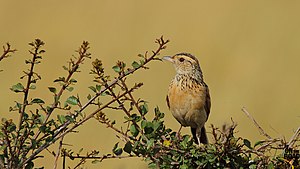Giant lark
| Giant lark | ||||||||||||
|---|---|---|---|---|---|---|---|---|---|---|---|---|

Giant lark |
||||||||||||
| Systematics | ||||||||||||
|
||||||||||||
| Scientific name | ||||||||||||
| Mirafra hypermetra | ||||||||||||
| ( Reichenow , 1879) |
The giant lark ( Mirafra hypermetra ) is a species from the lark family. With a body length of up to 21.5 centimeters, it is one of the largest species of lark. Their distribution area is in eastern Africa. There are four subspecies.
The IUCN classifies the Giant Lark population as not endangered ( least concern ).
features
The giant lark is about 10 percent larger than a skylark . It is a little darker overall and has a significantly longer and thicker beak. It reaches a body length of 19 to 21.5 centimeters, of which 7.2 to 9.3 centimeters are on the tail. The beak has a length of 2 to 2.4 centimeters. It weighs between 44 and 68 grams. There is no gender dimorphism .
The giant lark is black-brown on the upper side of the body, the individual feathers are lined with yellow or reddish tones. The chin and throat are whitish, the goiter and upper chest are yellow-reddish and have small black-brown spots. The rest of the underside of the body is light rust-brown. The under tail coverts are cream colored. The wings are red-brown to gray-brown. The control springs are gray-brown to black-brown, the outermost control spring has a reddish outer flag. The beak is horn-brown, with the lower beak slightly lighter. The iris is hazel brown, the feet and legs are light gray.
Fledglings differ from adult birds in that they have a darker upper body and a paler lower body.
Due to its size and its yellow-brown to red-brown wings, it is unmistakable for field observations.
singing
The song of the giant lark consists of loud, flute-like whistles that can be heard from afar. The individual phrases are repeated three to four times. The giant lark is one of those species that sometimes imitate the calls of other bird species with their song. In the case of chants that lasted over 15 minutes, the calls of around 20 other species have so far been identified.
Most of the singing can be heard from the waiting room. During the singing show flight, the male only rises to a height of three to six meters. One of the typical behavioral patterns of the giant lark is that it drops steeply after the end of the singing show flight and then walks a considerable distance on the ground.
Distribution area and habitat
The giant lark has a disjoint distribution area in eastern Africa. It occurs in the northeast of Tanzania, in large parts of Kenya, in the north of Uganda, in the south of Sudan as well as in the south and in the middle of Ethiopia. The extreme south of Somalia also belongs to the range. She is a resident .
The habitat of the giant lark are lowlands that are mostly grass and only a few bushes and trees. It is quite common in parts of the steppes of Danakil-Somalia .
Way of life
The giant lark eats insects and probably also seeds. Termites play a bigger role in their diet. During the hottest parts of the day, she takes shelter under tufts of grass. It rarely evades disturbances by being blown up, but uses the cover that the grass stock offers it.
Breeding birds were observed in Tanzania in November. In Somalia it breeds from April to June. Like all larks, it is a ground breeder. The nest is built hidden under tufts of grass. The clutch consists of two to four eggs. These are spotted olive-brown to reddish-brown on a whitish background.
Subspecies
There are four subspecies:
- M. h. kathangorensis - Cave , 1940 : Southeast Sudan
- M. h. kidepoensis - Macdonald , 1940 : South of Sudan and Northeast of Uganda
- M. h. gallarum - Hartert , 1907 : Ethiopia
- M. h. hypermetra - ( Reichenow , 1879) : southern Somalia to northeast Tanzania
literature
- Rudolf Pätzold: The larks of the world. Westarp Sciences, Magdeburg 1994, ISBN 3-89432-422-8 .
Web links
- Mirafra hypermetra inthe IUCN Red List of Threatened Species 2016.1. Posted by: BirdLife International, 2016. Retrieved January 7, 2017. </
- Song of the giant lark on Xeno-Canto
Single receipts
- ↑ Pätzold: The larks of the world. P. 53.
- ↑ Mirafra hypermetra in the IUCN Red List of Threatened Species 2016.1. Posted by: BirdLife International, 2016. Retrieved January 8, 2017.
- ↑ a b Pätzold: The larks of the world. P. 51.
- ↑ a b c Pätzold: The larks of the world. P. 52.
- ^ IOC World Bird List 6.4 . In: IOC World Bird List Datasets . September. doi : 10.14344 / ioc.ml.6.4 .
